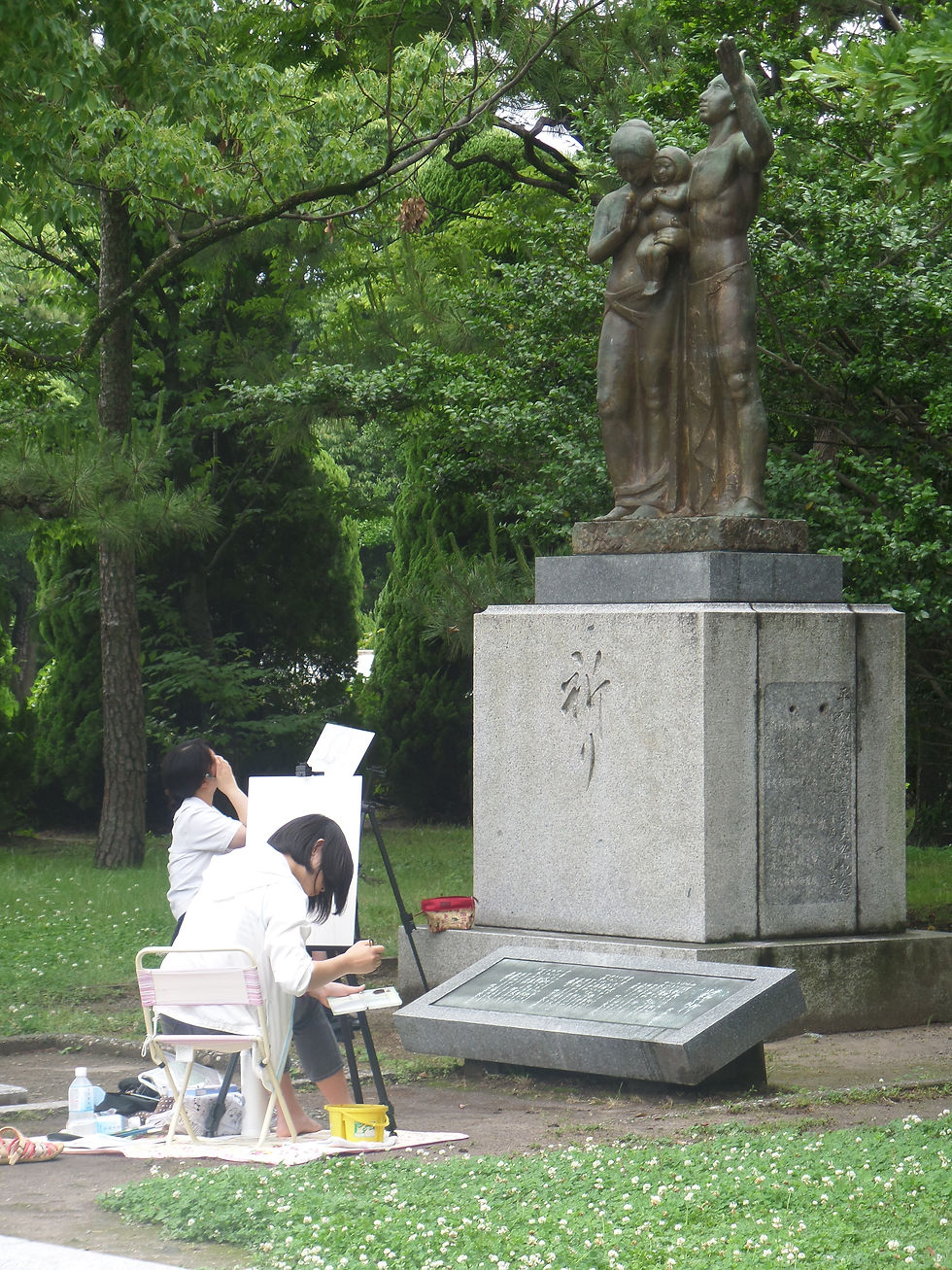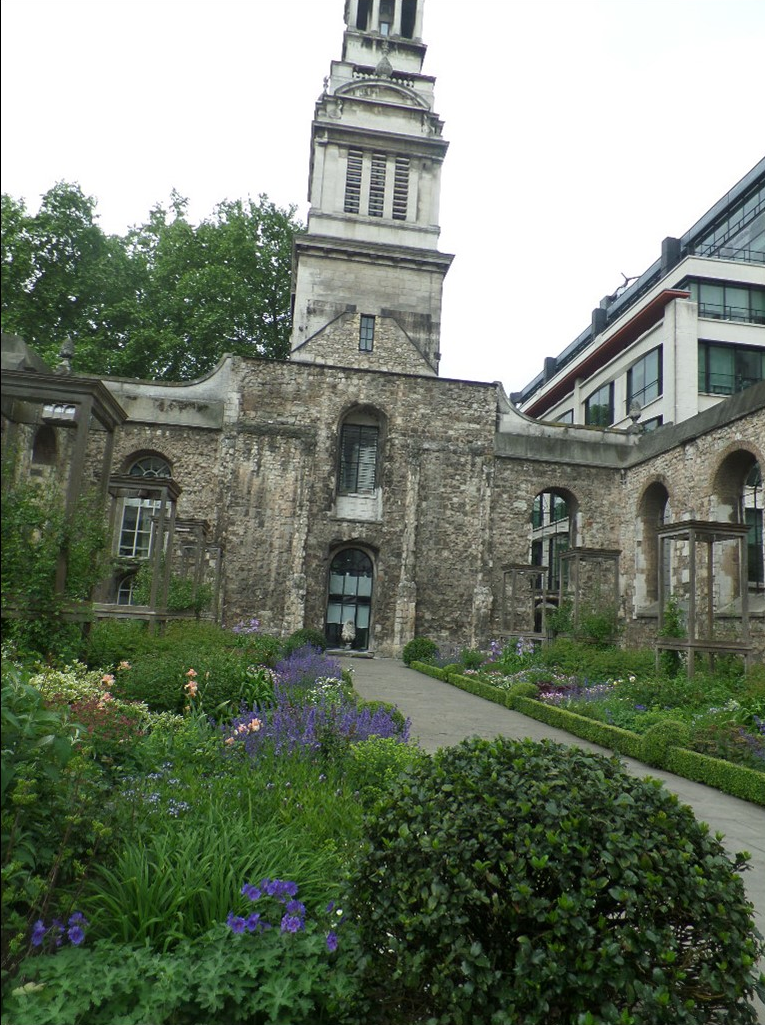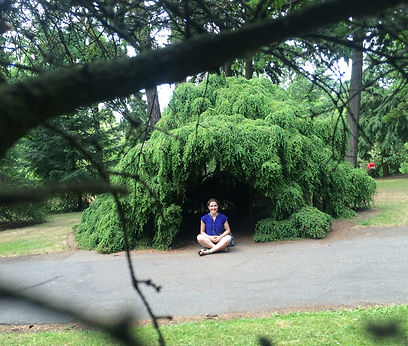
Healing: A Journey through
Destruction




While visiting Hiroshima, I was able to walk through Peace Memorial Park. The park is filled with monuments honoring the lost and is located less than 500 feet from where the atomic bomb was detonated. The building, pictured to the left, is the A-bomb Dome. It was one of the only remaining buildings standing after the bombing. It is surrounded by greenery and gardens.
Before visiting the park, I thought that I would feel sad thinking about the lives lost, but the first thing I noticed while visiting was how strangely beautiful the area was. It is largely a green space filled with nature. It was primarily a distraction from what I was viewing in front of me. The same thing occurred when we visited the many monuments in the area.
At the Children's Peace Monument, there are hundreds of thousands of origami cranes. Many of the cranes are arranged to form a picture and again I first focused on the art before thinking about the significance of the cranes which honor a young girl who died of radiation caused leukemia.
The art and nature in Peace Memorial Park serve as a distraction for the community in an area that would otherwise be an overwhelming reminder of the events that have occurred there. They are essentially mechanisms of healing.
Hiroshima
Healing comes after a destructive event and must occur to establish a new sense of balance.
I also observed ways that nature was being used in London like in Japan.
The image to the right is of a church in London that I passed while on a tour of the city. The church was hit during a German air raid during The Blitz in World War II. Instead of tearing down the church, which might have been easier, it was made into a garden that can be enjoyed by everyone. When I looked at the church I first noticed its uniqueness. Instead of focusing on the fact that this church had been destroyed during a turbulent time in the world's history, I focused on the nature that it now holds. Like art, nature can be distracting as well as make an individual reflective upon their own experiences or ordeals.
The church is no longer a painful memory, but stands as a memorial. Destruction is not something that can be forgotten, but it can be changed. The garden that is bordered by the church has made the church something different by becoming a distraction from a painful event. Again, I found that nature was being used as a healing mechanism to benefit a community.



 Nature and Design in Healthcare |
|---|
Mayo Clinic Center for Innovation Internship
During my capstone experience, I was a blogger for Mayo Clinic Center for Innovation. Due to my interest in nature and art, I was able to interview experts in the area of hospital design and art therapy. I was curious to know how nature and art are being brought to patients and used in the healing process since there is a correlation between a quick recovery and nature and the arts.
What I found was that modern hospitals are being developed with nature in mind. Larger windows and views of nature from patient rooms are a factor in patient care. Art is also being incorporated in patient care in ways that I would not have thought. The inclusion of nature and art in the healing process, especially in hospitals, benefits all communities as invariably, we will all spend time in a hospital at some point in our lives.
To read more, click here or watch the video below.



Immediately after the earthquake and tsunami that leveled Otsuchi-cho, the people started to practice a form of traditional Japanese stitching called Sashiko. The group that was started in a shelter is now called Sashiko Project.
The project provided an environment that facilitated healing through sharing of feelings and grief, creating a sense of community. The art of stitching allowed the Sashiko stitchers to also be distracted for a time on an individual level from the problems that they then faced and are still facing. The project has also brought awareness to Otsuchi-cho and provides the group with an income from the clothes and cloths that they embroider.
Otsuchi-cho, Japan
CLI 3711: The Healing Nature of Plants

Plants are used for therapeutic and medicinal purposes. There are 120 important chemicals that are derived from plants that are of medical importance. These chemicals are used in many of our medications, but plants have been used before these chemicals were ever discovered. Individuals can use plants directly to treat certain conditions. For example, Aloe vera is commonly used to treat burns and lavendar is used to reduce anxiety.
Plants have long been used for their medicinal properties, and more recently, they have been used for therapeutic means. Horticulture therapy can include therapeutic, social, and vocational pathways which all result in physical, psychological, social, and cognitive benefits in individuals.
Among the other benfits of plants, they have been seen to quicken recovery times. Patients that receive flowers have been seen to be in a more positive mood as well as have lower systolic blood pressure and heart rate and lower ratings of anxiety, pain, and fatigue.
Healing
Post-War British Popular Culture
While taking the course Post-War British Popular Culture, I was exposed to London's street art district, Shoreditch. Street art is basically graffiti with a purpose. It can serve as either a distraction or a statement piece that makes people either introspective or reflective. The piece of street art that struck me the most was done by a street artist named Citizen Kane (the black and red wall sculpture below). It is a memorial to his son who committed suicide in 2013. This piece is both a distraction and makes the observer retrospective. When looking at the piece, an observer does not know what it represents until they read the inscription "Dedicated to my late son Joe who took his own life a year ago today June 21, 2013" which makes the viewer retrospective. Many other pieces of street art are the same and make the observer think. They either serve as a distraction or a reflective piece for the viewer. Most pieces do not have inscriptions and are left up to the interpretation of the observer hence, affecting individuals differently and in many different ways.
The artists that make these pieces are also affected. The process of art can also be a distraction or reflective. I imagine that Citizen Kane found the process of making his son's memorial cathartic as well as a distraction from his son's death.
This type of art, individual rather than collective like I had observed in Japan, may say something about the differences in culture. While Japan in a collectivistic culture, England is more individualistic. Therefore, healing is different in each culture, but the same medium (art) can be used to heal.
 |
|---|
 |
 |
 |
 |
London, England
To heal, a community or individual has to find a new state of balance. In both Japan and London, I found that healing on a large scale is much the same as healing on a individual basis. In Japan, I was able visit a small fishing village, Otsuchi-cho, that was destroyed in the 2011 Tohoku Tsunami and Earthquake where they were able to utilize art as a healing mechanism; and while experiencing London, I observed some of these large scale coping strategies revolving around the arts and nature. On an individual basis, I was able to use these methods as well during a stressful time during my capstone.